In this second part of my look at the Van Beuren Tom & Jerry series (Part 1: click here), a new handful of characters are coming out of the closet.
In the Bag (3/26/1932, dir. John Foster and George Rufle)
 This short does not explicitly depict a queer-coded character, but instead plays on the audience’s perception of gender. It’s an interesting gag and rather than focusing on the performer’s sexualities, lightly challenges a viewer’s preconceived perception of what a female or a male character is supposed to “look” like. As an aside, a brief note for terminology: while today, “drag queen” is one way to describe a drag performer, during the period when In the Bag screened, the term female impersonation was used to describe this type of routine. In respect to historical accuracy, I shall be using the latter term.
This short does not explicitly depict a queer-coded character, but instead plays on the audience’s perception of gender. It’s an interesting gag and rather than focusing on the performer’s sexualities, lightly challenges a viewer’s preconceived perception of what a female or a male character is supposed to “look” like. As an aside, a brief note for terminology: while today, “drag queen” is one way to describe a drag performer, during the period when In the Bag screened, the term female impersonation was used to describe this type of routine. In respect to historical accuracy, I shall be using the latter term.
After their plane crashes, Tom and Jerry arrive in a Western town, where, following in the trend of Polar Pals and Jungle Jam there is another brief kiss gag with a bull. In a closeup shot, the bull, with noticeable eyelashes, kisses, and licks Tom’s face. Besides some visual discomfort, Tom does not show a strong reaction towards the bull, who afterwards becomes hostile towards Tom and tries to attack him. This scene is one of those gray areas in which I am more on the fence if the bull is supposed to be interpreted as coded. One can give a queer reading to this sequence, but considering how briefly the eyelashes appear, and the absence of other coded “signs,” I personally do not consider the bull to be a coded character. The eyelashes are a way of depicting him as “sweet” and it is important to remember that male characters throughout animation history have been depicted with eyelashes and it did not reflect their sexuality. Multiple lashes can heighten a gag, depict a character’s personality or emotions, or simply reflect an artist’s drawing style. In terms of artistic preference, Chuck Jones is a fantastic example of someone who enjoyed giving his characters noticeable lashes regardless of gender.
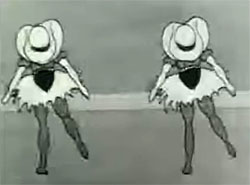 Later in the short, Tom and Jerry enter a saloon. After a comedic scene involving Jerry and a drink, laughter is heard, and it cuts to a dancing duo. The first part of the routine is quite simple with the dancers swinging their legs and shaking their behinds at the audience. In the second half, the dancers turn, and continue dancing, but keep their faces obscured. In this sequence, some rotoscoping is used. This was likely incorporated to help the animators perfect the female illusion before the finale “twist”. Finally, the dancers conclude their number. They push down their skirts turning them into chaps, raise their heads, and reveal themselves to be -not the expected pair of conventionally attractive women- but a duo of conventionally unattractive identical men, with mustached faces, five o’ clock shadows, missing teeth, and unibrows.
Later in the short, Tom and Jerry enter a saloon. After a comedic scene involving Jerry and a drink, laughter is heard, and it cuts to a dancing duo. The first part of the routine is quite simple with the dancers swinging their legs and shaking their behinds at the audience. In the second half, the dancers turn, and continue dancing, but keep their faces obscured. In this sequence, some rotoscoping is used. This was likely incorporated to help the animators perfect the female illusion before the finale “twist”. Finally, the dancers conclude their number. They push down their skirts turning them into chaps, raise their heads, and reveal themselves to be -not the expected pair of conventionally attractive women- but a duo of conventionally unattractive identical men, with mustached faces, five o’ clock shadows, missing teeth, and unibrows.
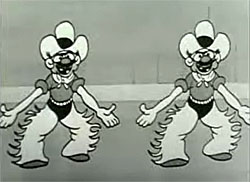 Readers here may have seen “reveals” from media, such as The Magic Christian (1969), Victor/Victoria (1982), or even RuPaul’s Drag Race. However, this aspect of drag history extends much further back. In the recently released book Glitter and Concrete: A Cultural History of Drag in New York City by Elyssa Maxx Goodman, drag history is explored from the 19th century to the modern day. Goodman details how in the 1920s, female impersonator and singer Karyl Norman would start his performance in feminine attire and sing in his soprano range. As the act continued, he’d do an on-stage costume change into overalls and shifted into a baritone for the remainder of the number.
Readers here may have seen “reveals” from media, such as The Magic Christian (1969), Victor/Victoria (1982), or even RuPaul’s Drag Race. However, this aspect of drag history extends much further back. In the recently released book Glitter and Concrete: A Cultural History of Drag in New York City by Elyssa Maxx Goodman, drag history is explored from the 19th century to the modern day. Goodman details how in the 1920s, female impersonator and singer Karyl Norman would start his performance in feminine attire and sing in his soprano range. As the act continued, he’d do an on-stage costume change into overalls and shifted into a baritone for the remainder of the number.
This dancing duo does not appear again in the short. What I find so interesting about this sequence is how isolated the act is. The men do not perform with Tom and Jerry in the same frame (nor for that matter do we know if Tom and Jerry even watched the routine). Often, a character’s reactions to a situation are supposed to reflect how the viewer is supposed to feel. In this scene though, it’s up to the viewer to individually interpret how to feel about the scene.
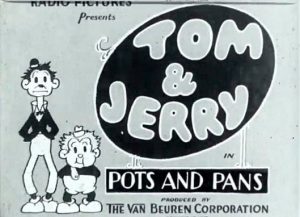 Pots and Pans (5/14/1932, dir. John Foster and George Rufle)
Pots and Pans (5/14/1932, dir. John Foster and George Rufle)
Tom and Jerry are operating a diner in a refurbished train car. In one scene, two coded customers are sitting next to each other as they eat their meals. The fellow on the right is a well-dressed, more stereotypical coded character (who for descriptor simplicity shall be described as pansy), while next to him is a rough and tough looking fellow complete with an eyepatch. With these visual designs, a viewer already has an idea of how these characters speak. When the pansy taps the rough one’s shoulder he tells him in a gruff tone, “Throw me the salt, bozo.” To which the tough looking man responds in a high-pitched voice, “Oh for heaven’s sake, why so rough?” and pushes the pansy back with his hand. The salt then springs to life, declaring a “Whoops!” before jumping into the pansy’s soup.
Two different stereotypes are depicted in this scene, the middle-class pansy character, and the working-class, possibly even “rough” trade type. George Chauncey’s Gay New York: Gender, Urban Culture, and the Making of the Gay Male World, 1890–1940 examines the complexities surrounding terms like trade and “rough”. While trade does have multiple meanings depending on the decade and individual, for this cartoon’s purpose I shall be aligning with the passing, hypermasculine interpretation. For “rough” Chauncey describes them as a “highly masculine working-class youth by wearing a chain with a cross around his neck.” Although this character doesn’t fit the description entirely, he still resembles the look of a trade character, has a high-pitched voice, and even says “rough” -serving as a double entendre- in his one line of dialogue. There’s too many coincidences for me to consider it purely accidental.
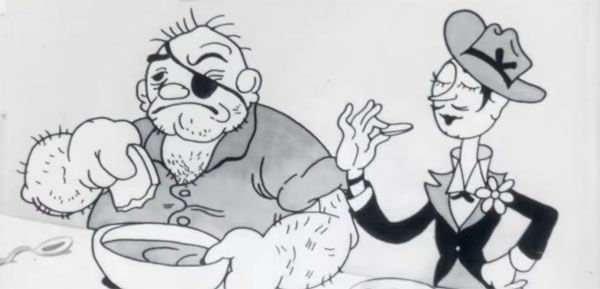
The “Whoops” phrase is quite a common exclamation you’ll hear during this period for coded characters. There’s a fantastic article in The Gay & Lesbian Review Worldwide, “The Company of ‘Whoops, M’dear’” by Laurence Senelick, which delves into the origin and history of “whoops.” By the early 1910s, the term already had associations with the queer male community, and for those “in the know” this utterance is another way for the viewers to recognize these men are supposed to be coded.
Pots and Pans and In the Bag share similarities with Trouble, in that they all include scenes where the coded characters serve a gag role which is unrelated to the main plot of the cartoon.
In all these shorts, after the joke, the coded characters disappear. Demonstrating how queerness is kept isolated within its own scene, rather than being allowed to occupy the larger space of the cartoon’s world. Their brief appearance does make me wonder if there were additional reasons why these scenes seem so isolated from the rest of the plot. Although I cannot currently confirm this (and I’d greatly appreciate any insights or comments on the matter), localized censorship that disagreed with these queer inclusions could simply edit out the gag rather than refusing to screen the entire short. Additionally (or alternatively), Van Beuren could have simply been testing the waters during this period to gauge how an audience would react to these types of jokes. Whatever the reasons are, by 1933, the coded characters would be given much longer scenes.


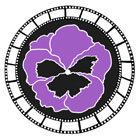

































I’d say that all of these gags fall within the general comedic principle of confounding the audience’s expectations. This of course includes gender stereotypes but is by no means limited to them; for example, comedian Jeff Cho, a Korean-American from Tennessee, could always be guaranteed a laugh in a bit part simply because we don’t expect Asians to speak with broad Southern accents. The same applies to the Van Beuren cartoons: when you have a bull by the horns, you don’t expect it to kiss you. It’s funny when the pansy talks like a tough guy and vice versa because we expect them each to talk in a particular way. If the tough guy in that scene was intended to be a queer coded character — and I’m not convinced of this — I doubt that most viewers at the time would have recognised him as such.
I think these queer coded characters appear only briefly because of the disjointed, gag-driven nature of the early Van Beuren cartoons. The bull and the dancing cowgirls/-boys do indeed disappear after their single scene in “In the Bag”, but then so do the banjo player, the bartender and the sheriff. I honestly don’t think Van Beuren was trying to make things easier for prospective censors; and in any case, when censors cut material they object to, they will do so without any consideration for story continuity.
In the 1960s, when it became fashionable for young men to grow their hair long, a common gag was to show a character with long, flowing hair from behind, who would then turn around to disclose a face with very masculine features and a full beard or five o’clock shadow. These gags don’t work today because we no longer associate hair length with gender; people of both sexes wear their hair however they choose.
Then there was the scene in the John Waters film “Pink Flamingos”, where a pervert flashes a woman in the park, and she — well, let’s just say she flashes him back, but oh my goodness, I wasn’t expecting THAT….
I agree with your insight on the bull, but agree to disagree about the tough character. Given his design, the audience may have expected something bad would happen to the pansy (after all he is a gay man), but instead, the man is also portrayed as queer. Once he speaks, visual cues are used to code him as such, his eyes are drawn differently with a more defined shape to make him appear more feminine, and he rests his hand on his hip like the pansy next to him.
The gay association with the term “rough” has associations with the queer male community before the 1930s and I’d say the design of the character is less to be wholly authentic of a “rough” trade at the time and more to capture a general look. Out of all the studios from this pre-Code period I’d say Van Beuren enjoyed experimenting the most with what queerness could “look” like. While I will save my elaboration for an upcoming article, the sequence in “Magic Mummy” is a fantastic example.
Additionally, including a joke that goes over a viewer’s head is not unusual, and I’d argue that’s the point. There’s countless examples one can list of animators sneakily including jokes, but even more harmless ones such as adding in a caricature of an animator like Ken Harris who appears in the much beloved THE DOVER BOYS AT PIMENTO UNIVERSITY (1942) would have been a reference completely lost to the majority of viewers when it screened.
During this period, gay identity was more focused on how “masculine” (or the lack thereof) someone presented. This meant that sissy portrayals were quite popular during this period, as it was easy visual shorthand, and it also allowed for gag twists of men who the audience initially thought would be “straight.” When the Code was enforced you’ll see more of an uptick of this type of joke, especially from Warner Bros. In the short INTO YOUR DANCE (1935) there’s a coded boxer character, and later shorts like SCREWBALL FOOTBALL (1939) included a gag involving football players. In regards to directors, well, Clampett could have his own multipart series with how much he loved the joke!
While I do agree about the gag driven nature of these shorts, as detailed in my article, the difference between the impersonation performers and other characters is that all those other characters interact directly with Tom and/or Jerry (but more-so with Jerry). Characters like the sheriff’s brief appearance are also relevant to the plot, and his scene cannot be cut without an audience becoming greatly confused. For the dancers, meanwhile, if they were edited out, though it would shorten the number and be an awkward transition -as Jerry who was at the bar is now suddenly playing an instrument with Tom- it still works without losing too much of the scene.
Truthfully, I’m still not sure if censorship was a possible reason why these scenes are so isolated, as you mentioned it can simply be because of the gag writing style. I do find how isolated they are to be quite interesting; especially given that this occurs nearly each time when it’s connected with queerness. Whatever the reason(s), by 1933, these characters did become more integrated in the stories.
The one that always shocked me was that Thimble Theater panel where Popeye wears a dress and says he’s “gender amphibious” or something like that. Certainly would read as a explicit coming out statement if said now but apparently was a throwaway line back then
I want to start off and give the disclaimer I’m not incredibly knowledgeable about the Thimble Theater comics, but I do know enough that I can give some minor thoughts on this topic. To start, while Popeye is depicted as fluid at times in the comics, I don’t consider the Thimble Theater comics and the Fleischer shorts to have an identical canon. Instead, I view them as two separate properties with some obvious overlap. I’m also still working my way through the Popeye cartoons, so these insights are focused more on Thimble Theater and not the Fleischer shorts.
Your recollection is almost correct, as in the actual panel he says “I yam amphibious” (panel linked near the end). I wouldn’t, however, necessarily view it as purely a throwaway line, as Popeye stated this feeling in another comic https://x.com/PopeyeTweetsk/status/1415775114004676614?s=20.
Interestingly, the official Popeye X (formerly Twitter) account used this line to celebrate Nonbinary day and included the famous panel https://twitter.com/PopeyeTweetsk/status/1416082950639267845. When someone asked for Popeye’s pronouns the response was “I ain’t use pronouns on account o’ all me nouns are amateurs!”
“Felix in Fairyland” (1923) has Felix rescuing a fly from flypaper. The fly says (in text boxes) “I’m not a regular fly! … I’m a fairy!”. Felix, amused, makes a fey gesture and does a little dance around the room. “No no! I’m a real fairy!” the fly says. The fly then turns into a storybook woman fairy, who grants Felix’s wish to visit Fairyland (with no further fairy jokes).
FELIX IN FAIRYLAND is a great short! I watched that scene about a year ago, and, after rewatching it again.. I’m still on the fence about it.
Now fairies were certainly used to describe gay men at this time, but I’ve flip flopped over whether this short is referencing that for a few reasons:
1. I haven’t seen enough Felix shorts to know if this was how they preferred to code gay men. Studios had their own preferences on how they coded, and until I watch more from that studio I’ll have a better idea.
2. Unfortunately, the current version online has quite a low resolution, making it difficult for me to see the gestures clearly. Especially the first gesture Felix makes. My current theory is that he’s simply waving his hands in a “no way” gesture.
3. The way Felix moves falls into a gray area. I’m not entirely sure what that first motion is, but his finger shake reminds me more of a scolding “don’t make up fibs” reaction. He then makes fun of the fly’s statement by imitating a mystical fairy, thus, the flapping is supposed to be an imitation of the wings. Of the works I’ve seen, however, that graceful jump at the end is more often associated with coded characters rather than the flapping movement.
4. The “‘No no! I’m a real fairy!’” line, I’m still not sure about. Yes, it could be in reference to the effeminate jump at the end, or the fly is simply emphasizing they aren’t a fake and are really telling the truth.
It’s still a great short though, just one I need to research more before I can say with full confidence that was the original intention.
I love this. This is great scholarship.
In the gag in Pots and Pans, initially, before they speak, one assumes that the two characters have nothing to do with each other and are next to each other by accident. Once they speak, are we to assume that they know each other, or are even a couple? How much are queer couples represented in cartoons of that time, as opposed to individual characters?
Thank you. I personally view the two as a general “in the family,” but not necessarily people that knew each other or are lovers. Visually, the two do remind me a bit of a proto Gus and Wally from MISSION HILL. Unfortunately, unless there are surviving notes about these two characters, given how brief the scene is, there was likely little thought placed into what the relationship would be besides let’s put the two coded characters together.
Now, queer couples, that’s something I can shed some light on, and could possibly be a great lecture idea! For this examination I am only focusing on American works. I’m also still slowly making my way through many of these studio outputs, so for simplicity I’ll focus more on the general overview.
The earliest explicitly queer couple depicted in animation is Krazy Kat and Ignatz from the 1910s. Krazy Kat seems to have been especially embraced by the queer community (as of my current research it seems gay men in particular enjoyed Krazy Kat). Typically, coded characters were either shown as individuals or in a group scene with an identical design and animation cycle. There is something to be examined about these group scenes, although the same design and animation really does boil down to easier work for the animators.
From my current research, besides some wedding gags that show up during the Code era (and even then one of the characters often takes on the “woman” role and presents as the bride complete with a wedding dress), queer couples, or discussions of being in some type of relationship does not occur until the late 60s.
All this history must come as something of a surprise to right-wing pundits who think homosexuality was invented by Mart Crowley in 1967.
Truthfully, I need to research Mart Crowley more myself! I haven’t seen either version of THE BOYS IN THE BAND, even though the original film is incredibly important in queer film history.
There are many people on the political spectrum who don’t know much about this history. Queer representation in animation is greatly under-examined and requires a knowledge not just about the coding in film, but about LGBTQ+ history. I’m glad my work allows an awareness of this history.